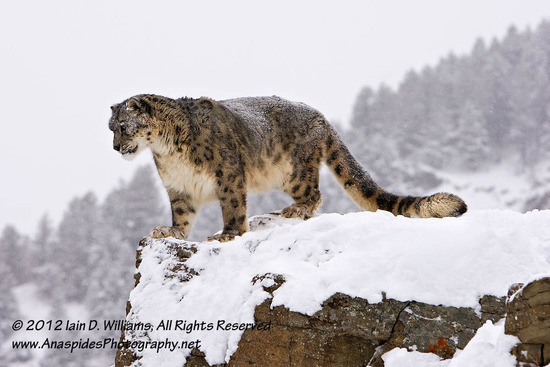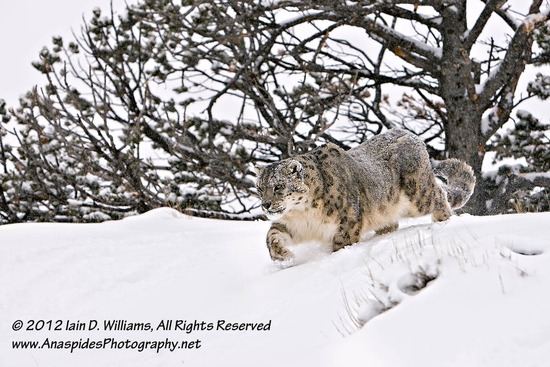 Most readers have seen pictures of leopards living in Africa, often seen in the branches of trees resting in the hot midday sun. Likewise, most people have seen the black panther; actually a leopard that has a gene for black fur, whose major habitat is upper south America. The snow leopard (Panthera uncia) is a animal rarely seen yet known outside it's major habitat, which is Central Asia.
Most readers have seen pictures of leopards living in Africa, often seen in the branches of trees resting in the hot midday sun. Likewise, most people have seen the black panther; actually a leopard that has a gene for black fur, whose major habitat is upper south America. The snow leopard (Panthera uncia) is a animal rarely seen yet known outside it's major habitat, which is Central Asia.
LEFT: A snow leopard (Panthera unicia) stands above a rocky outcrop. P.unicia derives much of its bulk from its thick fur, and is a moderate-sized cat belonging to the family Felidae. (click image to view larger).
Adaptations for Living in the Cold
A solitary animal, the snow leopard exhibits several adaptations for living in a cold  mountainous environment. Their bodies are stocky, their fur is thick, and their ears are small and rounded, all of which help to minimise heat loss. Their feet are wide, which distributes their weight better for walking on snow, and they have fur on their undersides to increase their traction on steep and unstable surfaces, as well as to assist with minimizing heat loss. Snow leopards' tails are long and flexible, helping them to maintain their balance. The tails are also very thickly covered with fur which, apart from minimizing heat loss, allows them to be used like a blanket to protect their faces when asleep.
mountainous environment. Their bodies are stocky, their fur is thick, and their ears are small and rounded, all of which help to minimise heat loss. Their feet are wide, which distributes their weight better for walking on snow, and they have fur on their undersides to increase their traction on steep and unstable surfaces, as well as to assist with minimizing heat loss. Snow leopards' tails are long and flexible, helping them to maintain their balance. The tails are also very thickly covered with fur which, apart from minimizing heat loss, allows them to be used like a blanket to protect their faces when asleep.
LEFT: A snow leopard (Panthera unicia) walks downslope through moderately deep snow (click image to view larger).
Population Numbers & Habitat
It's estimated that there roughly 4,080 to 6,590 individuals remaining in the wild (McCarthy, et al., 2003) and the snow leopard is listed on the IUCN Red List as endangered.
During the short summer months, snow leopards usually live at an altitude from 2,700 to 6,000 m (8,900 to 20,000 ft) above the tree-lime on mountainous slopes, meadows and in rocky regions . During winter, snow leopards move to lower elevations in search of prey. The habitat size of an individual snow leopard is quite variable; the smallest habitat range being observed in Nepal where individuals have a habitat range of 12 square kilometers. However, this is the exception and only occurs because prey species are abundant in Nepal
It's unfortunate, that this cat often comes into conflict with humans because if its habit of predating upon livestock. Although the snow leopard looks exceptionally fierce and aggressive, it's one of the more docile of felines.
To see more snow leopard photographs navigate to stock images.